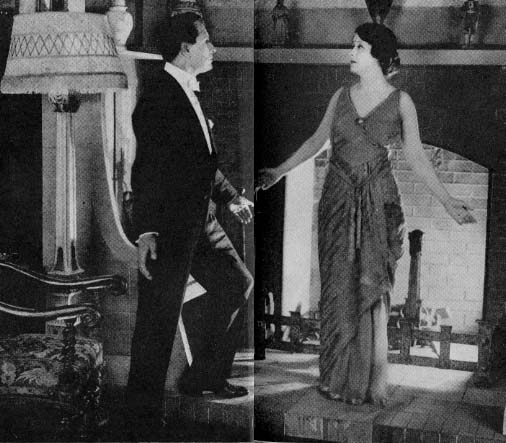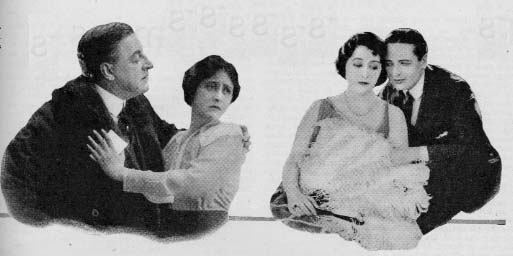

 |
| "The lover of today, I am convinced, is no different in anything but his clothes, from the lover of a thousand years ago. . . . It is natural that there should be many kinds of lovers, but it is extremely difficult to find the perfect specimen of each kind because men are naturally impatient. . . . A man painstaking over other matters, will frequently be satisfied with the commonest sort of mediocrity in his lovemaking." |
In these days of efficiency experts, machinery, standardization, and all the other short cuts constantly being invented to save time and trouble, it is pleasant to think that there is one corner of life which is immune from relentless progress.
The lover of today, I am convinced, is no different in anything but his clothes, from the lover of a thousand years ago. He is tender or thoughtless, patient or abrupt, marry or Byronic, considerate or selfish--in short, an artist or a carpenter. Of course, many a carpenter is an artist too, and takes a keen joy in the perfect matching of two pieces of timber. And many a self-styled artist is nothing but a carpenter. But you get the general idea. In love making, the artist is he who insists that all moments shall be beautiful, not he who thinks only of victory at any cost.
It is natural that there should be as many kinds of perfect lovers as there are kinds of men, but it is extremely difficult to find the perfect specimen of each kind, because men are naturally impatient. A man who will refuse to accept a suit until the tailor has perfected every stitch, who fusses and fumes over the least squeak in his automobile, who is a connoisseur of food, will frequently be satisfied with the commonest sort of mediocrity in his lovemaking. This is not surprising, of course, because he has no means of comparing his methods with those of other men. That is a privilege--or a trial--permitted, or visited upon, only women.
Yet men could learn, if they only would. But most of them are too egotistical, especially in this one matter. A man may specialize upon any other subject under the sun, and the more he studies the more he realizes there is to learn. He will admit that there is no end to research in electricity and metallurgy, but from the day the freckle-faced girl next door gives him a perfunctory kiss in exchange for a stick of peppermint candy, he thinks he knows all there is to know of love and how to make it. And when the woman does not respond to his ardor he declares that she is cold, unsympathetic and bloodless.
This too must be remembered--that a man who can make love perfectly to one sort of woman, will fail utterly with another. The Spanish lover would be doomed to celibacy in Iceland and the Russian would be pathetic in Iowa. The word "affinity" has been so misused and bandied about that one hesitates even to mention it, but in my opinion affinity means merely the perfect matching of technique and temperament. The two personalities fit each other like perfectly beveled cog-wheels of an intricate machine and without all the long processes of gradual adjustment, they begin spinning along at top speed.
 |
| "Paul Capellani, who played Armand to my Camille, is my real preference for a screen lover. . . . He has the foreign--Latin--technique, and men of the latin race are born lovers. This is undoubtedly due to the fact that they set their women on a pedestal, as opposed to the American tendency to make of their women companions." |
I wonder if men who see moving pictures note the differences between the love scenes. Sometimes these differences are subtle, and escape the casual observer, but no observation should be casual where so important a thing is under consideration. These differences have become especially fascinating to me, and as I look back over my pictures, it is interesting to study the various leading men who have played loves scenes with me. The list itself is somewhat appalling. For example, just recalled at random without digging into the records, I have been the object of the screen adoration of these players:
Joseph Kilgour, Conway Tearle, Milton Sills, Edmund Lowe, David Powell, Nigel Barrie, Earle Williams, Harry Morey, Maurice Costello, Paul Capellani, Rockcliffe Fellowes, Chester Barnett, Vernon Steele, Ralph Lewis, William Courtleigh and goodness knows how many more.
These men are all good lovers in their respective classes, and it would be well worth while for any man who is contemplating making love--and is there a man who is not--to consider their various characteristics and see which is best adapted to his own personality, and to the susceptibilities of her to whom he intends to make love. And what a lot of unhappiness it would save the woman if men would engage in such a study. Just by way of helping a good cause along, I will call attention to some of the more obvious characteristics in some of these lovers--oh, merely as they have been exemplified in their work with me on the screen. Let it be distinctly understood that this discussion is absolutely impersonal.
 |
|
| "Rockcliffe Fellowes was the rugged westerner in "The Easiest Way." |
One of the interesting types of screen lovers is David Powell, my sarcastic suitor in "The Price She Paid." His technique in this story is one I would not recommend for general use, as he made love with "reverse English." He ploughed his way into my frivolous affections by telling me I didn't amount to much, and concealing his interest beneath a highly superior attitude. Of course, this sort of thing rather piques a certain type of woman, who is conscious of her charm, and regards treatment like that as a challenge.
Going to the other extreme, there was Nigel Barrie, who besieged me in "The Marionettes" and "The Better Wife." Here is the juvenile and impetuous type, the lover who pursues the cave man tactics. "Catch them young and treat them rough" is the motto of the lovers of this class. It is said that women love brutes--though far be it from me to insinuate that there is anything brutal about Mr. Barrie in his love scenes--and I suppose this has its foundation in our instinctive admiration for strength. For countless centuries the sole bulwark between woman and a savage and predatory world, was man's physical strength. Now that we are more civilized, at least in the social relations of men and women, there lurks in the subconscious mind of woman, perhaps the feeling that her man must be a fighter. And when a lover displays something of the "cave man" she is thrilled. At least, I believe some women are. I have been so advised.
 |
|
| "Nigel Barrie, in "The Better Wife" was the juvenile and impetuous type, the lover who pursues the cave man tactics." |
The idea can be carried too far. Personally I think such a technique should be judiciously tempered with a little of the delicacy of feeling that was always characteristic of the amatory art of Maurice Costello, back in the Vitagraph days. It was a delight to play love scenes with him for that very reason.
For contrasted techniques in lovemaking, there is perhaps no better single array of talent than in "Eyes of Youth" in which I had four lovers--Edmund Lowe, Ralph Lewis, William Courtleigh and Milton Sills, representing respectively youthful sincerity, middle aged selfishness, greedy sensuousness, and casual nonchalance. Here in the latter three instances are excellent examples of what not to be. The middle aged man who makes love by offering bribes should remember that love is one commodity that cannot be listed in the market quotations. All he can buy is a spurious imitation.
After all, the lovemaking that does not rest upon a solid foundation of sincerity must fail, no matter what may be its other characteristics, or how fine its technique, and for this reason Conway Tearle is one of the most satisfactory of screen suitors. That is why he is always in demand when a serious and determined lover is wanted, as in "The Common Law" and "The Forbidden Woman." In moments of disappointment he can give an impression, perhaps more intense than any other leading man I ever knew, that the entire world has collapsed, and what woman could resist such an appeal to her sympathies?
 |
|
| "For the reason that sincerity must form the solid foundation of lovemaking that it is successful. Conway Tearle is one of the most satisfying screen suitors. That is why he is always in demand when a serious and determined lover is wanted, as in "The Common Law." |
Milton Sills, on the other hand, in such stories as "The Claw" and "The Savage Woman," never permits the impression that he is beaten. There is something of the "I'll get her yet" expression about his eyes that arouses admiration rather than sympathy. And after all, there is something compelling about that sort of lover.
So the variety, infinite and fascinating, goes on. There was Chester Barnett, the pathetic Little Billee to my "Trilby," as unhappy a lover as the world has ever known, but hardly a type of lover because he was a victim of circumstances that he could not possibly control. There was Earle Williams, the dignified gentleman type, and Harry Morey who takes one back to the primitive. There was Joseph Kilgour, the suave, man-about-town, and Rockcliffe Fellows, the rugged westerner, excellent contrasts in "The Easiest Way." There was Vernon Steele in "Hearts in Exile," a charming composite of the aristocratic romantic and esthetic lover.
My own preference? This is purely my personal viewpoint, but of all the screen lovers I have had, I really believe I prefer Paul Capellani, who played Armand to my "Camille." Of course, Mr. Capellani had all the advantages in the world , for Armand is a wonderful role, and should inspire any man who has the least germ of talent for lovemaking. But in addition to that he has the foreign--perhaps I should say the latin technique. The men of the latin races are born lovers. This is undoubtedly because in the Anglo-Saxon countries women have been more companions of men. The latins set their women apart, on a pedestal perhaps you might say, and study them in all their manifestations. There is much to be said for both viewpoints.
The American, for example, does not study women, and for that matter American women discourage men from studying them--as women. American women have demanded equality, and they deserve equality. But in fighting for that equality they have voluntarily relinquished their former prerogatives. Women in this country have been so insistent upon their claim that mentally and psychologically there is no difference between the sexes, that men have begun to believe it. Consequently they jump to the conclusion that women react to the same impulses and emotions as themselves, and make love as they would want a woman to make love to them if the situation was reversed.
 |
|
| Left: "Joseph Kilgour--suave, man-about-town, in "The Easiest Way." Right: "Then, there was Edmund Lowe, in "Eyes of Youth," typifying in contrast to the other three men, youthful sincerity." |
Last revised July 7, 2002